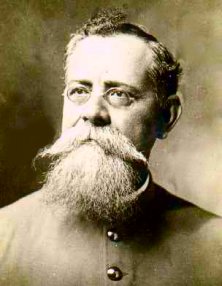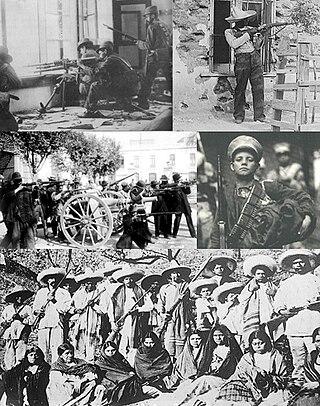热门问题
时间线
聊天
视角
墨西哥革命
来自维基百科,自由的百科全书
Remove ads
墨西哥革命(西班牙語:Revolución Mexicana)是指1910年—1920年墨西哥各派系之間的長期流血鬥爭,以結束獨裁統治、建立立憲共和國告終。革命後由革命制度黨長期執政,直至2000年。
Remove ads
Remove ads
歷史




革命起因於人民對墨西哥總統波菲里奧·迪亞斯長期獨裁統治的普遍不滿。
1910年,迪亞斯想第7次連選連任總統,引起弗朗西斯科·馬德羅以「反對連任黨」領導人身份宣布自己為候選人。迪亞斯逮捕了馬德羅,於6月舉行假選舉,宣布自己獲勝。馬德羅獲釋後,被迫流亡美國,在德克薩斯州聖安東尼奧發布「聖路易斯波托西計劃」,號召11月20日舉行起義。起義失敗後,墨西哥國內的馬德羅支持者,包括龐丘·維拉、埃米利亞諾·薩帕塔等人向政府發動戰爭。在北方,帕斯夸爾·奧羅斯科和龐丘·維拉動員他們的部隊襲擊政府駐軍;在南方,薩帕塔開展反對地方政治首腦的流血鬥爭。1911年春,革命軍攻克毗鄰美墨邊境的華雷斯城,加上一連串的軍事勝利,迫使迪亞斯辭職,迪亞斯政權滅亡。革命派迎接馬德羅回國成為總統。
然而馬德羅政府從一開始就不穩定,馬德羅並未實現革命前包括土地改革的承諾。薩帕塔對馬德羅不立即將土地歸還給被剝奪土地的印第安人表示憤怒,轉而反對他。馬德羅支持者奧羅斯科不滿新政府改革步伐緩慢,也在北方發動了反政府運動。美國擔心總統馬德羅過於妥協,怕墨西哥內戰影響美國的商業利益,也轉而反對馬德羅。當獨裁者迪亞斯的侄子費利克斯·迪亞斯領導的軍隊和維克托里亞諾·韋爾塔指揮的聯邦軍隊在墨西哥城發生衝突時,局勢極為緊張。
1913年2月18日韋爾塔和迪亞斯在美國大使亨利·萊恩·威爾遜辦公室簽署所謂「大使館計劃」,商定共同反對馬德羅,由韋爾塔出任總統。次日,馬德羅被捕,被迫辭職,韋爾塔就任總統。數日後馬德羅被暗殺。在北方,反對韋爾塔專橫統治的力量也發展起來,龐丘·維拉、阿爾瓦羅·奧夫雷貢和貝努斯蒂亞諾·卡蘭薩結成聯盟。革命派的卡蘭薩提出「瓜達盧佩計劃」,要求韋爾塔辭職。
1914年春夏期間,起義軍圍攻墨西哥城,韋爾塔出走。8月20日,卡蘭薩不顧維拉反對,宣布自己為總統。國家陷入混亂和流血的狀態,直至維拉、奧夫雷貢和薩帕塔舉行會議,一致認為維拉和薩帕塔之間的鬥爭使秩序無法恢復,並選舉尤拉利奧·古鐵雷斯為臨時總統。



維拉支持古鐵雷斯,奧夫雷貢則與卡蘭薩聯合,於1915年4月在塞拉西擊敗維拉。卡蘭薩再次任總統。他主持起草1917年憲法,賦予總統以獨裁權力,但規定政府有權沒收富有地主的土地,保障工人權利和限制羅馬天主教的權利。為了保持自己的權力,他清除異己,在1917年暗殺了薩帕塔。
1917年,卡蘭薩修改了墨西哥憲法,使得墨西哥民主化。但當他在1920年企圖破壞索諾拉的鐵路工人罷工時,反對他的浪潮達到頂點,實際上他已眾叛親離。他在5月21日企圖逃跑時被殺。阿道弗·德拉韋爾塔任臨時總統,直到11月奧夫雷貢當選總統為止。許多歷史學家認為,墨西哥革命在1920年即告結束。
然而,奧夫雷貢任總統,聯邦軍和叛軍之間的衝突時有發生,墨西哥軍事政變頻頻,直至1934年革命制度黨改良主義者拉薩羅·卡德納斯就任總統後才算平靜下來。而革命後由革命制度黨長期執政,直至2000年。
Remove ads
參見
參考文獻
本條目包含來自公有領域出版物的文本: Chisholm, Hugh (編). Encyclopædia Britannica (第11版). London: Cambridge University Press. 1911.
- Chasteen, John. Born In Blood and Fire: A Concise History of Latin America. New York:
- Documents on the Mexican Revolution Vol.1 Part 1. ed. Gene Z. Hanrahan. North Carolina: Documentary Publications, 1976
- Gonzales, Michael J. "The Mexican Revolution: 1910–1940" Albuquerque: University of New Mexico Press, 2002.
- Hauss Charles, Smith Miriam, "Comparative Politics", Nelson Thomson Learning, Copyright 2000
- Knight, Alan. The Mexican Revolution, Volume 1: Porfirians, Liberals, and Peasants (1990); The Mexican Revolution, Volume 2: Counter-revolution and Reconstruction (1990)
- Lucas, Jeffrey Kent. The Rightward Drift of Mexico's Former Revolutionaries: The Case of Antonio Díaz Soto y Gama. Lewiston, New York: Edwin Mellen Press, 2010.
- Macias, Anna. "Women and the Mexican Revolution, 1910–1920." The Americas, 37:1 (Jul., 1980), 53–82.
- Meyer, Jean A. The Cristero Rebellion. Cambridge: Cambridge University Press, 1976, pp. 10–15
- Quirk, Robert E. The Mexican Revolution and the Catholic Church 1910–1919. Bloomington: Indiana University Press, 1973, pp. 1–249
- Reed, John. Insurgent México. New York: International Publishers, 1969. "[A] collection first published by John Reed himself in 1914 ... [of] John Reed's reportage of his days with the Mexican guerillas under Pancho Villa, establish[ing] him [i.e. Reed] as a top journalist of his time." -- From the pbk. book's back cover. ISBN 0-7178-0099-7
- Reséndez Fuentes, Andrés. "Battleground Women: Soldaderas and Female Soldiers in the Mexican Revolution." The Americas 51, 4 (April 1995).
- Ruiz, Ramón Eduardo. The Great Rebellion: Mexico, 1905-1924 (1980).
- Smith, Robert Freeman. The United States and Revolutionary Nationalism in Mexico 1916–1932. Chicago: University of Chicago Press, 1972
- Snodgrass, Michael. Deference and Defiance in Monterrey: Workers, Paternalism, and Revolution in Mexico, 1890–1950. Cambridge University Press. 2003. ISBN 0-521-81189-9.
- Soto, Shirlene Ann. Emergence of the Modern Mexican Woman. Denver: Arden Press, 1990.
- Swanson, Julia. "Murder in Mexico." History Today, June 2004. Vol.54, Issue 6; p 38–45
- Turner, Frederick C. "The Compatibility of Church and State in Mexico." Journal of Inter-American Studies, Vol 9, No 4, 1967, pp. 591–602
- Womack, John. Zapata and the Mexican Revolution (1968)
- Britton, John A. Revolution and Ideology Images of the Mexican Revolution in the United States. Louisville: The University Press of Kentucky, 1995.
- Doremus, Anne T. Culture, Politics, and National Identity in Mexican Literature and Film, 1929–1952. New York: Peter Lang Publishing Inc., 2001.
- Foster, David, W., ed. Mexican Literature A History. Austin: University of Texas Press, 1994.
- Hoy, Terry. "Octavio Paz: The Search for Mexican Identity." The Review of Politics 44:3 (July, 1982), 370–385.
- Mora, Carl J., Mexican Cinema: Reflections of a Society 1896–2004. Berkeley: University of California Press, 3rd edition, 2005
- Myers, Berbard S. Mexican Painting in Our Time. New York: Oxford University Press, 1956.
- Noble, Andrea, Photography and Memory in Mexico: Icons of Revolution. Manchester: Manchester University Press, 2010.
- Noble, Andrea, Mexican National Cinema, London: Routledge, 2005.
- Orellana, Margarita de, Filming Pancho Villa: How Hollywood Shaped the Mexican Revolution: North American Cinema and Mexico, 1911–1917. New York: Verso, 2007
- Paranagua, Paula Antonio. Mexican Cinema. London: British Film Institute, 1995.
- Weinstock, Herbert. "Carlos Chavez." The Musical Quarterly 22:4 (Oct., 1936), 435–445.
- Knight, Alan. "The Mexican Revolution: Bourgeois? Nationalist? Or Just a 'Great Rebellion'?" Bulletin of Latin American Research (1985) 4#2 pp. 1–37 in JSTOR (頁面存檔備份,存於互聯網檔案館)
- Wasserman, Mark. "You Can Teach An Old Revolutionary Historiography New Tricks Regions, Popular Movements, Culture, and Gender in Mexico, 1820–1940," Latin American Research Review (2008) 43#2 260-271 in Project MUSE
- Young, Eric van. "Making Leviathan Sneeze: Recent Works on Mexico and the Mexican Revolution," Latin American Research Review (1999) 34#2 pp. 143–165 in JSTOR (頁面存檔備份,存於互聯網檔案館)
Remove ads
- Brunk, Samuel. The Banditry of Zapatismo in the Mexican Revolution The American Historical Review. Washington: April 1996, Volume 101, Issue 2, Page 331.
- Brunk, Samuel. "Zapata and the City Boys: In Search of a Piece of Revolution." Hispanic American Historical Review. Duke University Press, 1993.
- "From Soldaderas to Comandantes" Zapatista Direct Solidarity Committee. University of Texas.
- Gilbert, Dennis. "Emiliano Zapata: Textbook Hero." Mexican Studies. Berkley: Winter 2003, Volume 19, Issue 1, Page 127.
- Hardman, John. "Soldiers of Fortune" in the Mexican Revolution. "Postcards of the Mexican Revolution"
- Merewether Charles, Collections Curator, Getty Research Institute, "Mexico: From Empire to Revolution" (頁面存檔備份,存於互聯網檔案館), Jan. 2002.
- Rausch George Jr. "The Exile and Death of Victoriano Huerta", The Hispanic American Historical Review, Vol. 42, No. 2, May 1963 pp. 133–151.
- Tannenbaum, Frank. "Land Reform in Mexico". Annals of the American Academy of Political and Social Science, Vol. 150, Economics of World Peace (July 1930), 238–247.
- Tuck, Jim. "Zapata and the Intellectuals. (頁面存檔備份,存於互聯網檔案館)" Mexico Connect, 1996–2006.
Remove ads
外部連結
- Library of Congress--Hispanic Reading Room portal, Distant Neighbors: The U.S. and the Mexican Revolution (頁面存檔備份,存於互聯網檔案館)
- EDSITEment's Spotlight: The Centennial of the Mexican Revolution, 1910-2010 from EDSITEment, "The Best of the Humanities on the Web"
- U.S. Library of Congress Country Study: Mexico (頁面存檔備份,存於互聯網檔案館)
- Mexican Revolution of 1910 and Its Legacy (頁面存檔備份,存於互聯網檔案館), latinoartcommunity.org
- Women and the Mexican Revolution (頁面存檔備份,存於互聯網檔案館) on the site of the University of Arizona
- Stephanie Creed, Kelcie McLaughlin, Christina Miller, Vince Struble, Mexican Revolution 1910–1920 (頁面存檔備份,存於互聯網檔案館), Latin American Revolutions, course material for History 328, Truman State University (Missouri)
- Mexico: From Empire to Revolution (頁面存檔備份,存於互聯網檔案館), photographs and commentary on the site of the J. Paul Getty Trust
- Mexican Revolution, ca. 1910-1917 Photos and postcards in color and in black and white, some with manuscript letters, postmarks, and stamps from the collection at the Beinecke Rare Book and Manuscript Library at Yale University (頁面存檔備份,存於互聯網檔案館)
- Papers of E. K. Warren & Sons, 1884–1973, ranchers in Mexico, Texas and New Mexico (頁面存檔備份,存於互聯網檔案館), held at Southwest Collection/Special Collections Library at Texas Tech University
- Mexican Revolution (頁面存檔備份,存於互聯網檔案館), in the "Boys' Historical Clothing" website. This is an overview of the Revolution with a treatment of the impact on children.
- SMU's Mexic : graphs from the DeGolyer Library (頁面存檔備份,存於互聯網檔案館) contains dozens of photographs (頁面存檔備份,存於互聯網檔案館) related to the Mexican Revolution.
- Time line of the Mexican Revolution (頁面存檔備份,存於互聯網檔案館)
Remove ads
Wikiwand - on
Seamless Wikipedia browsing. On steroids.
Remove ads

